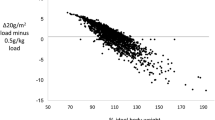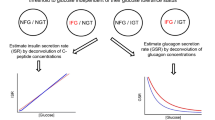Evaluation of beta cell function is conducted by a variety of glucose tolerance tests and evaluated by a number of different models with less than perfect consistency among results obtained from different tests. We formulated a new approximation of the distributed threshold model for insulin secretion in order to approach a model for quantifying beta cell function, not only for one, but for several different experiments. Data was obtained from 40 subjects that had both an oral glucose tolerance test (OGTT) and an intravenous tolerance test (IVGTT) performed. Parameter estimates from the two experimental protocols demonstrate similarity, reproducibility, and indications of prognostic relevance. Useful first phase indexes comprise the steady state amount of ready releasable insulin A 0 and the rate of redistribution k rd , where both yield a considerable correlation (both r=0.67) between IVGTT and OGTT estimates. For the IVGTT, A 0 correlates well (r=0.96) with the 10 min area under the curve of insulin above baseline, whereas k rd represents a new and possibly more fundamental first phase index. For the useful second phase index γ, a correlation of 0.75 was found between IVGTT and OGTT estimates.





Similar content being viewed by others
Abbreviations
- AUC:
-
Area under the curve
- BG:
-
Baseline glucose
- BOV:
-
Between occasion variability
- BSV:
-
Between subject variability
- CV:
-
Coefficient of variation
- FDR:
-
First degree relatives to patients with diabetes
- HGC:
-
Hyperglycaemic clamp
- IVGTT:
-
Intravenous tolerance test
- MTT:
-
Meal tolerance test
- OGTT:
-
Oral glucose tolerance test
- RRI:
-
Ready releasable insulin
- RRP:
-
Ready releasable pool
- SE:
-
Standard error
REFERENCE
Beal, S. L., L. B. Sheiner. NONMEM user's guides. NONMEM Project Group. San Francisco: University of California, 1994.
Breda, E., M. K., Cavaghan, G. Toffolo, K. S., Polonsky, and C. Cobelli. Oral glucose tolerance test minimal model indexes of beta-cell function and insulin sensitivity. Diabetes 50(1):150–158, 2001.
Bruce, D. G., D. J. Chisholm, L. H. Storlien, and E. W. Kraegen. Physiological importance of deficiency in early prandial insulin secretion in non-insulin-dependent diabetes. Diabetes 37(6):736–744, 1988.
Cerasi, E. An analogue computer model for the insulin response to glucose infusion. Acta Endocrinol. (Copenh) 55(1):163–183, 1967.
Dea, M. K., M. Hamilton-Wessler, M. Ader, D. Moore, L. Schaffer, M. Loftager, A. Volund, R. N. Bergman. Albumin binding of acylated insulin (NN304) does not deter action to stimulate glucose uptake. Diabetes 51(3):762–769, 2002.
Del Prato, S., P. Marchetti, and R. C. Bonadonna. Phasic insulin release and metabolic regulation in type 2 diabetes. Diabetes 51(Suppl 1):S109–S116, 2002.
Expert Committee Report of the expert committee on the diagnosis and classification of diabetes mellitus. Diabetes Care 26(Suppl 1):S5–S20, 2003.
Fritsche, A., N. Stefan, E. Hardt, H. Haring, M. Stumvoll. Characterisation of beta-cell dysfunction of impaired glucose tolerance: evidence for impairment of incretin-induced insulin secretion. Diabetologia 43(7):852–858, 2000.
Gerich, J. E. Is reduced first-phase insulin release the earliest detectable abnormality in individuals destined to develop type 2 diabetes? Diabetes 51(Suppl 1):S117–S121, 2002.
Grodsky, G. M.. A threshold distribution hypothesis for packet storage of insulin and its mathematical modeling. J. Clin. Invest 51(8):2047–2059, 1972.
Henriksen, J. E., F. Alford, A. Handberg, A. Vaag, G. M. Ward, A. Kalfas, and H. Beck-Nielsen. Increased glucose effectiveness in normoglycemic but insulin-resistant relatives of patients with non-insulin-dependent diabetes mellitus. A novel compensatory mechanism. J. Clin. Invest 94(3):1196–1204, 1994.
Henriksen, J. E., F. Alford, G. M. Ward, and H. Beck-Nielsen. Risk and mechanism of dexamethasone-induced deterioration of glucose tolerance in non-diabetic first-degree relatives of NIDDM patients. Diabetologia 40(12):1439–1448, 1997.
Henriksen, J. E., T. T. Durck, M. Rasmussen, K. Levin, and H. Beck Nielsen. Dexametazone induced glucose intolerance predicts the development of diabetes in relatives of Type 2 diabetic patients 10 years later. Diabetologia 47(Suppl 1):A403, 2004.
Hiriart, M., M. C. Ramirez-Medeles. Functional subpopulations of individual pancreatic B-cells in culture. Endocrinology 128(6):3193–3198, 1991.
Karpe, F., B. A. Fielding, J. L. Ardilouze, V. Ilic, I. A. Macdonald, and K. N. Frayn. Effects of insulin on adipose tissue blood flow in man. J. Physiol. 540(Pt 3):1087-1093, 2002.
Licko, V., and A. Silvers. Open-loop glucose-insulin control with threshold secretory mechanism: analysis of intravenous glucose tolerance tests in man. Math. Biosci. 27:319–332, 1975.
Mari, A., O. Schmitz, A. Gastaldelli, T. Oestergaard, B. Nyholm, and E. Ferrannini. Meal and oral glucose tests for assessment of beta -cell function: modeling analysis in normal subjects. Am. J. Physiol. Endocrinol. Metab. 283(6):E1159–E1166, 2002.
Mari, A., A. Tura, A. Gastaldelli, and E. Ferrannini. Assessing insulin secretion by modeling in multiple-meal tests: role of potentiation. Diabetes 51 Suppl 1:S221–S226, 2002.
Nesher, R., and E. Cerasi. Modeling phasic insulin release: immediate and time-dependent effects of glucose. Diabetes 51(Suppl 1):S53–S59, 2002.
O'Connor, M. D., H. Landahl, and G. M. Grodsky. Comparison of storage- and signal-limited models of pancreatic insulin secretion. Am. J. Physiol 238(5):R378–R389, 1980.
Overgaard, R. V., J. E. Henriksen, and H. Madsen. Insights to the minimal model of insulin secretion through a mean-field beta cell model. J. Theor. Biol. 2005.
Pipeleers, D. G. Heterogeneity in pancreatic beta-cell population. Diabetes 41(7):777–781, 1992.
Pipeleers, D., R. Kiekens, Z. Ling, A. Wilikens, and F. Schuit. Physiologic relevance of heterogeneity in the pancreatic beta-cell population. Diabetologia 37(Suppl 2):S57–S64, 1994.
Rask, E., T. Olsson, S. Soderberg, J. J. Holst, A. Tura, G. Pacini, B. Ahren. Insulin secretion and incretin hormones after oral glucose in non-obese subjects with impaired glucose tolerance. Metabolism 53(5):624–631, 2004.
Steil, G. M., C. M. Hwu, R. Janowski, F. Hariri, S. Jinagouda, C. Darwin, S. Tadros, K. Rebrin, and M. F. Saad. Evaluation of insulin sensitivity and beta-cell function indexes obtained from minimal model analysis of a meal tolerance test. Diabetes 53(5):1201–1207, 2004.
Stumvoll, M., A. Mitrakou, W. Pimenta, T. Jenssen, H. Yki-Jarvinen, H. T. Van, W. Renn, J. Gerich. Use of the oral glucose tolerance test to assess insulin release and insulin sensitivity. Diabetes Care 23(3):295–301, 2000.
Toffolo, G., R. N. Bergman, D. T. Finegood, C. R. Bowden, and C. Cobelli. Quantitative estimation of beta cell sensitivity to glucose in the intact organism: a minimal model of insulin kinetics in the dog. Diabetes 29(12):979–990, 1980.
Toffolo, G., F. De Grandi, C. Cobelli. Estimation of beta-cell sensitivity from intravenous glucose tolerance test C-peptide data. Knowledge of the kinetics avoids errors in modeling the secretion. Diabetes 44(7):845–854, 1995.
Van Schravendijk, C. F., R. Kiekens, and D. G. Pipeleers. Pancreatic beta cell heterogeneity in glucose-induced insulin secretion. J. Biol. Chem. 267(30):21344–21348, 1992.
Author information
Authors and Affiliations
Corresponding author
Appendices
APPENDIX A
In the present appendix we use the original threshold distribution hypothesis10 to derive the equations for the active and passive amounts of insulin presented in the main text. This derivation involves three approximations/alterations to the original model that can be applied in arbitrary order, for instance as described below.
The fundamental hypothesis in the original distributed threshold model is that the readily releasable insulin is stored in small packets, where the different packets have different thresholds, secreting insulin into the plasma only when the glucose concentration has exceeded this threshold. The amount of readily releasable insulin in packets with threshold between θ and θ+dθ is given by \(\xi (\theta ,t)d\theta\), so the threshold density distribution function can be used to model the total secretion into plasma. The original distributed threshold model,10 can be written as,
The secretion of insulin into the plasma is realized through the first term, where H(·) is the Heaviside function. The second term is the provision of new insulin, and the last two terms are named redistribution terms corresponding to a random change of thresholds of the different packets. Note that \(f'(\theta) = d/d\theta f(\theta)\), is the distribution density function. In the original analysis glucose started at zero, so that f ′(θ) gives the initial insulin distribution density function ξ(θ,0). I passive and I active can be written as,
The differential equations for I passive and I active can be derived analytically,
The first suggested alteration to the distributed threshold model involves unidirectional flow of insulin from passive packets to active packets. Note that the beta cell action potential will either spike or not, where a spike will lead to exocytosis. It is not possible to stop the spike by a decrease in glucose and thereby stopping exocytosis of insulin that is currently being released, motivating a unidirectional flow. Whereas this change does simplify the model structure, the rate constant m is so large that it does not alter the results. We get,
In the distributed threshold model, redistribution can be understood as a random change in the sensitivity to glucose, where passive packets may change threshold but still be passive. This formulation is slightly changed. In the present model, redistribution involves random activation of packets, in the sense that a passive packet may by a random mechanism release all insulin in its ready releasable pool, and then return to the passive state. By this mechanism, redistribution will not decrease to zero when all packets are passive. The equations become,
The two alternative models for redistribution were compared during model development, and the chosen formulation produced superior correlations between OGTT and IVGTT parameter estimates, superior objective function value, and was numerically more robust when changing initial estimates in the estimation.
The central approximation in the present approach is that all passive packets contain the same amount of insulin, so that \(\xi (G,t) = I_{passive} f(G)/(1 - f(G))\). This approximation will not be influential during simple glucose challenge tests, where glucose is single peaked. But if a second and identical peak is seen immediately after the first peak, the threshold distribution hypothesis will predict the second peak to give no first phase, because the passive packets involved are empty, whereas the present approximation will predict a nonzero first phase, since all passive packets contain the same amount of insulin. This difference may be of particular relevance for predictions of insulin response to rapid oscillations in glucose. Following this approximation we get the equations for the amount of insulin in the passive and active packets that were presented in the main text,
APPENDIX B
The present appendix provides the exact solution to the amount of insulin in the passive and active packets following a step increase in glucose from G 1 to G 2, at time t=0. Starting at the steady state solution:
For a step increase in glucose, the Ph 1 contribution can be computed via a Dirac delta-function,
The amount of insulin in the passive packets can be computed as
where the first term reflects the immediate removal of insulin due to packet activation, corresponding to the first phase release. The second term D(t) represents the elevation in the amount of insulin in the passive packets coming from an elevated provision, i.e. the second phase contribution to the passive packets. α and k rd constitute the two timescales for the second phase contribution. Since α is more than a factor 10 larger than k rd , the main contribution of the delayed increase of the second phase comes from k rd .
The amount of insulin in the active packets can be computed as,
where the first term in I active corresponds to the initial amount, the second term is the first phase contribution, and the third term D 2 gives the second phase contribution. Since m leads to a rather fast decay compared to the remaining time scales, it is reasonable to approximate D 2(t) as,
One part originates from the immediate increase in provision and another part originates from the steady increase in passive packets.
Rights and permissions
About this article
Cite this article
Overgaard, R.V., Jelic, K., Karlsson, M. et al. Mathematical Beta Cell Model for Insulin Secretion following IVGTT and OGTT. Ann Biomed Eng 34, 1343–1354 (2006). https://doi.org/10.1007/s10439-006-9154-0
Received:
Accepted:
Published:
Issue Date:
DOI: https://doi.org/10.1007/s10439-006-9154-0




